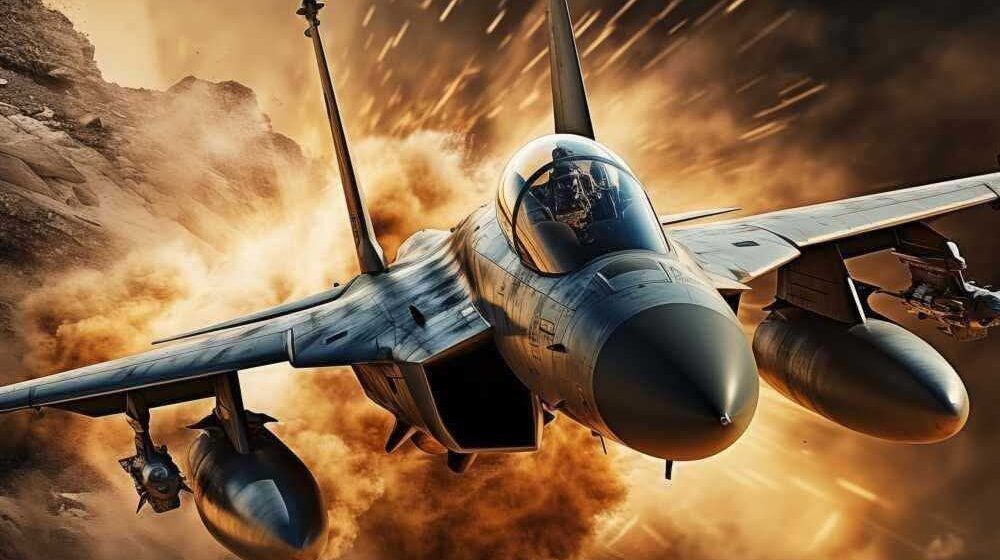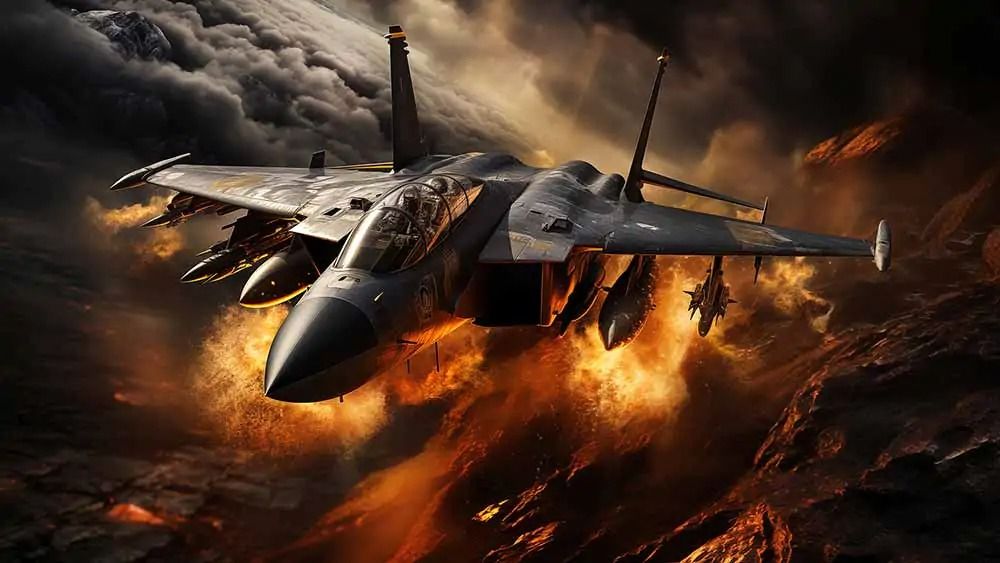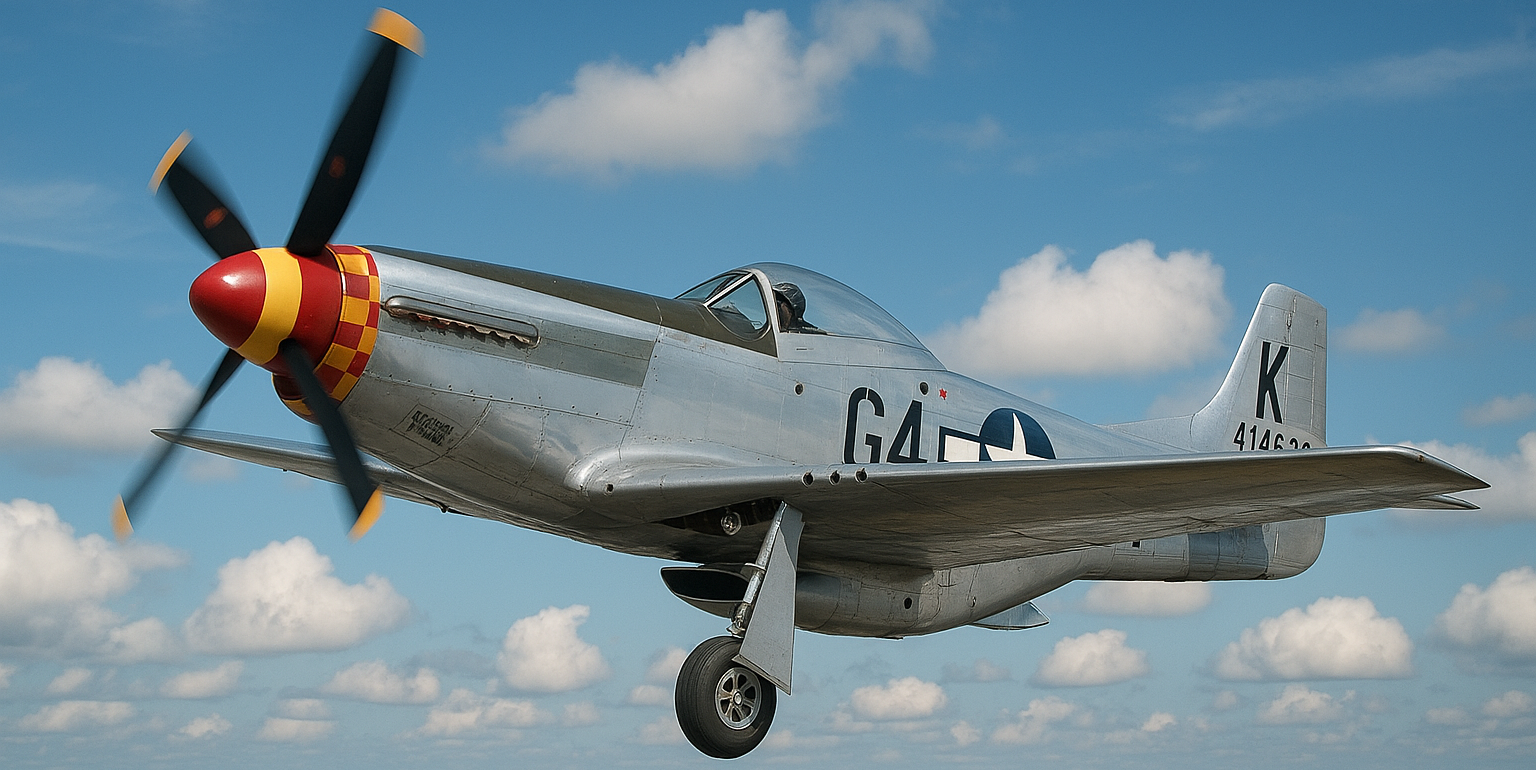The Mustang Fighter Aircraft was conceived in 1940 by North American Aviation( NAA) inventor James H. Kindleberger and his team in response to a British Purchasing Commission demand
The North American P- 51 Mustang Fighter Aircraft is an American single- seat, long- range fighter and fighter- bomber aircraft employed in World War II and posterior warfare, including the Korean War. NAA was commissioned by the RAF to produce Curtiss P- 40 fighter planes under license. rather of producing an aged design of another establishment, NAA offered to design and manufacture a newer type of fighter. The first prototype NA- 73X airframe was finished on 9 September 1940, 102 days since subscribing the contract, and flew for the first time on 26 October

The Mustang Fighter Aircraft was firstly designed to employ the Allison V- 1710 machine without the turbosupercharger ormulti- stage supercharger that was import-sensitive, thereby having reduced high- altitude performance. The airplane was operationally flown and fairly successfully by the RAF firstly and subsequently as a politic- surveillance airplane and fighter- bomber( Mustang Fighter Aircraft Mk I). Inmid- 1942, a development design called the Rolls- Royce Mustang X substituted the Allison machine with a Rolls- Royce Merlin 65 two- stageinter- cooled supercharged machine. In testing on Rolls- Royce’s field at Hucknall, England, it was clear the machine significantly increased the performance of the aircraft over 15,000 bases( 4,600 m) without punishing range. On entering test reports and further USAAF birdman flights, the results were so encouraging that North American started to convert several aircraft into P- 51B/ C( Mustang Fighter Aircraft Mk III) types. The product interpretation, the P- 51D, was powered by the Packard V-1650-7, a licence- erected variant of the two- stage, two- speed Merlin 66 supercharger, and carried six.50 in( 12.7 mm) AN/ M2 Browning machine artillery.
From 1943 late to 1945, the P- 51B and P- 51C were supplemented, starting inmid- 1944, by the P- 51D, all being employed by the USAAF’s Eighth Air Force to companion bombers on raids into Germany; Merlin- powered Mustangs were employed as fighter- bombers by the RAF’s Alternate Tactical Air Force and the USAAF’s Ninth Air Force, the Mustang Fighter Aircraft contributing to Allied air supremacy in 1944. P- 51s also served with Allied air forces in the North African, Mediterranean, Italian, and Pacific theaters. In World War II, Mustang Fighter Aircraft fliers reckoned for 4,950 adversary planes destroyed.
When the Korean War began, the Mustang Fighter Aircraft, now called the F- 51, was the primary American fighter airplane until spurt fighters, analogous as the North American F- 86 Sabre, replaced it in this part; The Mustang Fighter Aircraft also operated as a specialist fighter- bomber. Indeed after the development of spurt fighters, the Mustang Fighter Aircraft still saw service with some air forces until the early 1980s. Following the Korean War, Mustangs were popular greedy combat planes and air racing planes.
Mustang Fighter Aircraft plane design and performance
The P-51 Mustang Fighter Aircraft is celebrated for its design and speed, mainly its laminar flow wing and effective cooling system, which helped make it highly effective in World War II. Its top speed is about 437 mph, with a combat range of approximately 1,650 miles. The design of the Mustang Fighter Aircraft included low drag as the main consideration, with aspects such as a smooth airframe, covered landing gear, and well-planned cooling system.
P-51 Mustang Fighter Aircraft bomber escort missions
The P-51 Mustang Fighter Aircraft played a crucial role in bomber escort missions in World War II, especially over the European continent. Its high altitude performance, long range, and speed enabled it to cover Allied bombers deep into hostile territory, providing vital protection against German fighters. This helped significantly diminish bomber losses and assist the Allies in gaining air superiority.
Key Aspects of P-51 Mustang Fighter Aircraft Bomber Escort Missions:
Long Range
The Merlin-driven P-51s, with drop tanks, had the capability to go deep into Germany and return.
High Altitude Performance
The Mustang performed better in higher altitudes, as it was able to outperform and outfight most German fighters such as the Me 109 and Fw 190.
Reduced Bomber Losses
By successfully engaging German fighter planes, the P-51s kept the threat to the bomber formation down, resulting in fewer losses and greater mission success.
Shift in Air Superiority
The P-51, arriving in large quantities, contributed to the Allies’ achievement of air superiority over Europe at the expense of the Luftwaffe and overall Allied success.
Escort in Multiple Theaters
Although mostly famous for Europe, the P-51 also escorted bombers in the Pacific theater, especially B-29s flying over Japan following the capture of Iwo Jima.
Beyond Escort
P-51s were also employed in secondary tasks, such as RAF and Ninth Air Force fighter-bomber sorties in Europe.
Legacy
The P-51 Mustang continues to be an iconic plane and is still flown and admired today in airshows and as a civilian warbird

Why was the Mustang fighter so effective in WWII?
The P-51 Mustang performed so well in WWII because it combined speed, range, and firepower so effectively, especially with the Merlin engine. These characteristics enabled it to perform exceptionally well as a long-range escort fighter, defending Allied bombers and interfering with enemy air operations.
Here’s the breakdown in a little more detail
Exceptional Range
The Mustang’s laminar flow wing and effective engine cooling in its design reduced drag considerably, allowing it a greater range than most other fighters during that period. This enabled it to cover the bombers on deep penetration missions into enemy-held territory, such as those to Germany.
High-Altitude Performance
First, the Mustang had limited high-altitude capabilities, but with the addition of the Rolls-Royce Merlin engine with its supercharger, it was revolutionized. It could now effectively fight enemy fighters at high altitudes, a key feature for escort work.
Firepower
The Mustang was equipped with six .50 caliber machine guns, which made it a formidable force against enemy aircraft. The aircraft could also be loaded with rockets and bombs for ground attack.
Adaptability
The versatility of the Mustang enabled it to be applied across a range of roles, including ground attack, reconnaissance, and escort, thus rendering it a priceless asset to the Allied forces.
Production Scale
The P-51 was manufactured in high quantities so that a large force of effective fighters could be committed to the European theater.

P-51 Mustang vs German Luftwaffe fighters
The P-51 Mustang was an incredibly successful fighter against German Luftwaffe planes in World War II, especially at the altitudes that Allied bombers flew. Although the Messerschmitt Bf 109 and Focke-Wulf Fw 190 were resistant foes, the Mustang’s greater range, speed, and agility, particularly at higher altitudes, made it superior to the skies and give crucial escort to bombing missions. The Me 262 jet’s introduction, nevertheless, created a new challenge with the ability to outfly the Mustang in level speed, though its operational limitations and fuel usage problems usually detracted from its effectiveness, in accordance with analysis in a YouTube video
Famous P-51 Mustang pilots in WWII
Some of the most famous pilots that flew the P-51 Mustang during WWII include George Preddy, John F. Thornell Jr., and William T. Whisner. George Preddy, in particular, is especially famous as the war’s highest-scoring Mustang ace, as rated by Midwest Aero Restorations.
The following are some of the most famous P-51 Mustang pilots
George E. Preddy Jr.: USAAF Major with 26.83 aerial victories, which made him the number-one P-51 ace of the war. He flew the now famous “Cripes A Mighty”.
John F. Thornell Jr.: USAAF Lieutenant with 17.25 aerial victories and flying the P-51 Mustang.
William T. Whisner: A Captain in the USAAF, Whisner was yet another highly prolific Mustang pilot, with 15.5 aerial successes.
Wayne K. Blickenstaff: A Lieutenant Colonel, Blickenstaff had 10 aerial victories in the P-51.
Robert J. Goebel: A Captain in the USAAF, Goebel scored 11 aerial victories in the P-51.
William J. Dillard: A Captain, Dillard scored 6 aerial victories in the P-51.
Harry W. Dorris: A Major, Dorris recorded 5 aerial victories flying the P-51.
Frederick J. Dorsch Jr.: A Captain, Dorsch accounted for 8.5 aerial victories flying the P-51.
Conclusion
The P-51 Mustang is more than a plane—it is a symbol of technological genius, wartime valor, and Allied resolve. Its success in World War II made it a turning point in the air, securing air supremacy over Europe and safeguarding bomber missions vital to ultimate victory. This status as an overarching instrument of Allied air power cemented its place in history.
Beyond its wartime victory, the Mustang became an enduring symbol of freedom and innovation. Even years later, it still evokes respect at airshows, in museums, and in the imaginations of aviation buffs. Restored Mustangs soaring today remind us of the sacrifices of yesterday and the working spirit of yesterday’s progress.
Essentially, the Mustang is not just recalled as a mythic warbird but also hailed as an enduring symbol of bravery, engineering prowess, and triumph over adversity.
FAQ
Why was the P-51 Mustang ranked as one of the greatest fighter planes of WWII?
Due to its speed, range, and powerful Rolls-Royce Merlin engine, it was able to escort bombers deep into enemy territory and outfly German fighters.
What was the maximum speed of the Mustang fighter plane?
The P-51 Mustang had a top speed of approximately 437 mph (703 km/h), placing it among the fastest of the time.
Who constructed the P-51 Mustang?
It was designed and constructed by North American Aviation (NAA) in the United States.
What was the Mustang’s contribution to World War II?
Its primary contribution was as a long-range escort fighter for Allied bombers, but it was also useful in dog fighting and ground attack.
What engine contributed to the success of the Mustang?
Its Rolls-Royce Merlin V-12 engine (under license to Packard in the U.S.) provided it with excellent speed and high-altitude flying capabilities.
How did the Mustang stack up against German Luftwaffe fighters?
It bettered most of the German fighters such as the Messerschmitt Bf 109 and Focke-Wulf Fw 190, providing the Allies with unequivocal air supremacy.
Were P-51 Mustangs utilized post-WWII?
Yes, they kept serving in the Korean War and were operated by many air forces throughout the globe for years.
Can you still find a P-51 Mustang today?
Yes, there are many restored Mustangs in museums and airshows, and some are even privately owned.
How many P-51 Mustangs were produced?
Approximately 15,000 P-51s were produced in WWII.
Why is the P-51 Mustang referred to as a “warbird”?
The term “warbird” is used to describe WWII-era military planes that became legendary for their effect and legacy, and the Mustang is perhaps the most legendary example.

